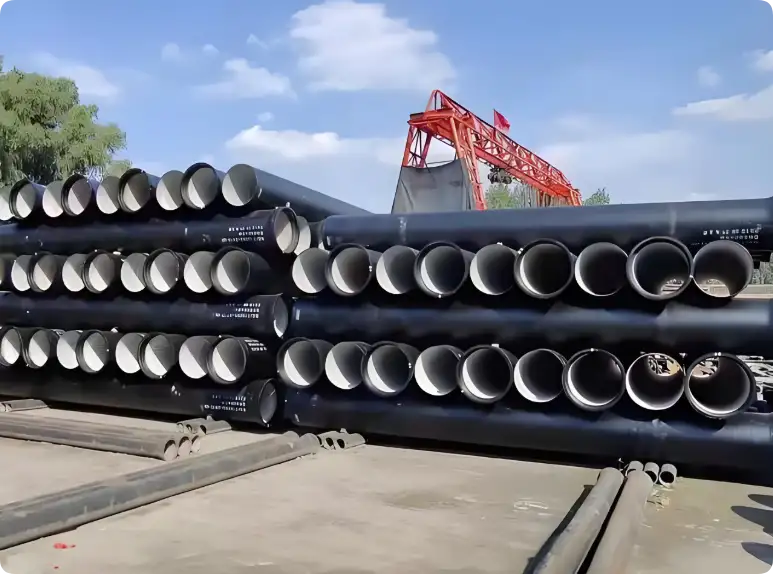How long do ductile iron pipes actually last? what is the multifaceted factors influencing ductile iron pipe life expectancy.

1. The Baseline: Typical Lifespan of Ductile Iron Pipes
Industry studies and real-world applications reveal that ductile iron pipes typically deliver 75–120 years of service life under standard conditions. This range reflects:
-
Material Properties: The spheroidal graphite structure enhances tensile strength (≥420 MPa) and impact resistance compared to gray iron.
-
Corrosion Protection: Modern DIP employs cement mortar lining (CML) and polyethylene encasement, meeting AWWA C104/C151 standards.
-
Historical Data: Installed pipelines from the 1950s–60s remain operational in cities like Tokyo and Munich with minimal rehabilitation.
2. Key Factors Affecting Longevity
2.1 Environmental Conditions
-
Soil Corrosivity: Resistivity (< 1,000 Ω·cm), pH (<5 or >10), and chloride/sulfate concentrations accelerate corrosion. Polywrap or V-Bio® coatings mitigate this risk.
-
Stray Currents: Electrified rail systems or improper grounding reduce lifespan by 15–40% in affected areas.
-
Temperature Extremes: Frost heave (sub-0°C) and thermal expansion (>40°C) stress joints.
2.2 Installation Practices
-
Trench Preparation: Poor bedding (e.g., sharp rocks) causes point loading; AWWA M41 recommends granular materials with ≤12% fines.
-
Joint Integrity: Push-on joints require <1° deflection per ANSI/AWWA C111; excessive angular deflection leaks invite corrosion.
-
Surge Pressure Management: Water hammer exceeding 2× working pressure fatigues pipes over time.
3. Maintenance Strategies to Extend Service Life
-
Cathodic Protection: Impressed current systems reduce corrosion rates by 90% in aggressive soils (NACE SP0169).
-
Lining Rehabilitation: Spray-on polyurethane liners restore hydraulic efficiency and prevent tuberculation (AWWA C602).
-
Smart Monitoring: Acoustic leak detectors and inline CCTV inspections enable proactive repairs.
4. Comparative Analysis: DIP vs. Alternative Materials
| Material | Avg. Lifespan | Failure Rate (/100 km/yr) | Cost per Meter (USD) |
|---|---|---|---|
| Ductile Iron | 75–120 yrs | 2–5 | 80–150 |
| PVC | 50–75 yrs | 8–12 | 40–90 |
| HDPE | 50–100 yrs | 3–7 | 60–110 |
| Steel (lined) | 40–70 yrs | 10–15 | 120–200 |
Source: International Water Association (IWA) 2022 Report
5. Case Studies: Real-World Longevity
-
Singapore PUB: 98% of DIP networks installed since 1985 remain in service with <0.2% annual repair rate.
-
Denver Water, USA: A 1938 ductile iron main required only two repairs before retirement in 2018.
-
Riyadh, Saudi Arabia: High-salinity soils reduced lifespan to 55 years until V-Bio® wraps were adopted in 2005.
6. Industry Standards & Certifications
-
ISO 2531: Global benchmark for dimensional tolerances and pressure ratings.
-
EN 545: European standard for pipe durability in aggressive environments.
-
AS/NZS 2280: Australasian specifications for trenchless installation compatibility.
7. Future-Proofing: Innovations in DIP Technology
-
Nanocomposite Linings: Graphene-enhanced epoxy coatings reduce biofilm growth by 70% (University of Cambridge trials).
-
IoT-Enabled Pipes: Embedded sensors monitor wall thickness and stress in real time (e.g., Sentryx Pro® system).
-
Recyclability: 95% of DIP material is recyclable, aligning with UN Sustainable Development Goal 6.
8. When Does Replacement Become Necessary?
Watch for these red flags:
-
Wall Thinning: Ultrasonic testing showing <75% original thickness.
-
Corrosion Pitting: Depth exceeding 20% of nominal wall (per AWWA Manual M41).
-
Frequent Breaks: >3 failures/km/year indicates systemic deterioration.
Ductile iron pipe life expectancy isn’t a fixed number—it’s a function of science, engineering, and stewardship. By selecting certified products, adhering to AWWA installation guidelines, and implementing condition-based maintenance, stakeholders can reliably achieve century-scale performance. As climate change intensifies infrastructure stresses, DIP’s proven resilience positions it as a sustainable choice for 21st-century utilities.

